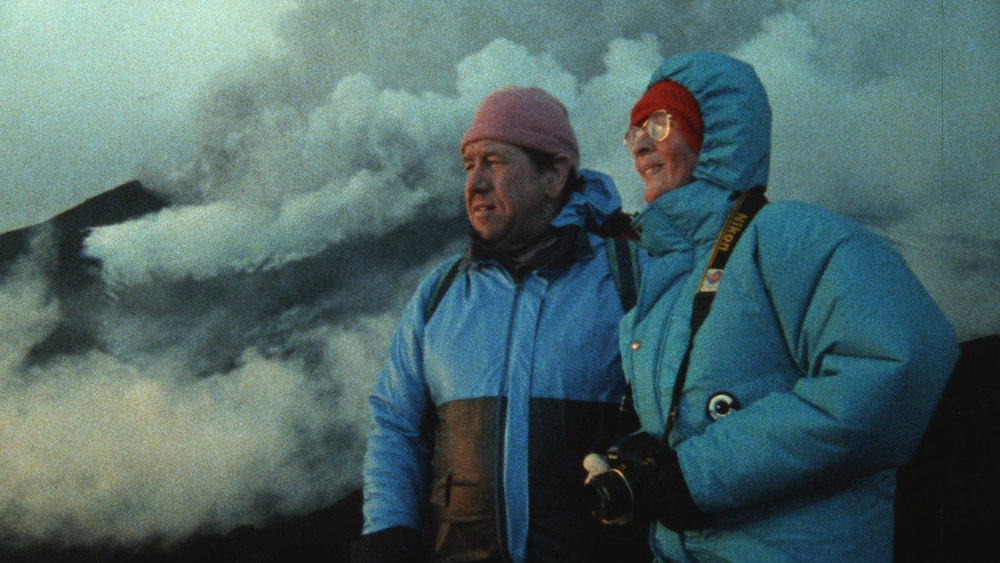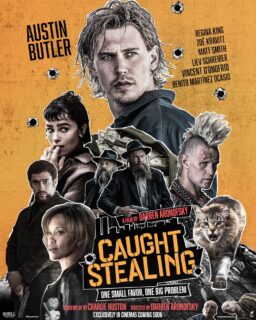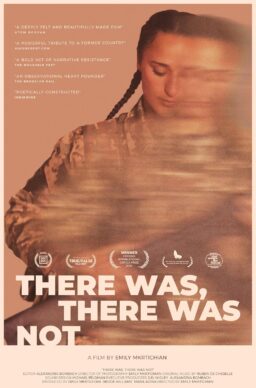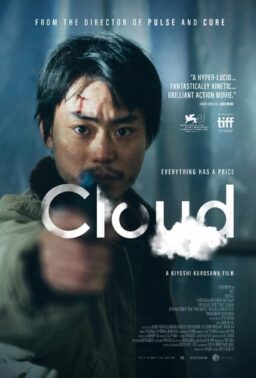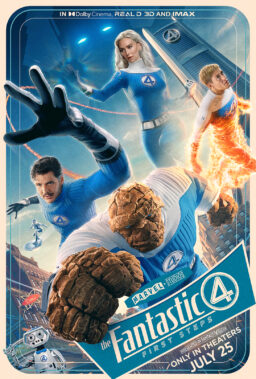A volcano’s eruption, spewing lava in its giddiness, is a many splendored thing. So too is a relationship that seems to have been as certain as the earth’s movement, as if it were too a science. This is the phenomenon of Katia and Maurice Krafft, two people who were bonded by their love for volcanology. Together they would study magma, formations, the movement of the earth, sometimes in mighty close proximity to death. Maurice even dreamed of riding a canoe on lava, as part of his desire to live fast, preferring volcanoes to people. The opening footage of the film about them captures them alone, navigating a tricky rock formation, in silence. They were in tune with each other and with the earth, as this instance among many others indicates.
Katia and Maurice captured their work, and themselves, in photographs and footage that provide this documentary with its treasure trove of visuals. Hypnotic images of magma bubbling, bursting, the earth ripping open. But they were stars in front of the camera as well—baked into the footage is dry visual comedy that reminds you how much Wes Anderson took from a French documentarian’s eye and wit. Not to mention the intrigue, danger, and adventure that surrounds them. Sara Dosa’s “Fire of Love” doesn’t just celebrate them as volcanologists, or devoted lovers, but as extraordinary visual storytellers.
“Fire of Love” tells the story of their adventures, of finding volcanoes and documenting them. This tribute is a mostly peaceful, meditative experience, with death just below the surface—early into the film, it talks about how they would pass during one of their expeditions, but leaves that alone until later. Dosa treats the story with immense care, and her multi-frame collages, montages, and plentiful bursts of natural humor are complemented by a score from Air’s Nicolas Godin that adds to its sincere whimsy. Forming a type of love letter to a couple that we know from the past, the narration read by Miranda July makes you appreciate each wistful stanza (“Alone they can only dream of volcanoes; together, they can reach them.”) How special when a documentary can give you ways to appreciate volcanoes, and also a healthy relationship.
In a manner that one can imagine would make Katia and Maurice proud, the documentary passes along information about volcanoes—the safer red ones, the dangerous grey ones; the difference between magma and lava—but through its observational approach. This has to be one of the most heartwarming movies about scientists ever made, especially as it always honors the red-hot nature in their shared passion.

“Riotsville, USA,” a documentary screening in the festival’s experimental NEXT category, is made entirely of archival footage recorded by the US military and for news broadcasts from the late 1960s. Its images reflect back on us, as Sierra Pettengill (credited as director and archival researcher) gives us a carefully curated tour through the American police credo of “law and order.” Such “law and order” is represented with a stark microcosm—a fake main street created by the military, to practice riot control and stoke fires of police power.
This footage of Riotsville, a bizarre piece of unreality that also illustrates the grandiose delusion of American policing, is always presented in disquieting fashion—it’s worth the price of admission alone. Military men dress up in protestor garb, waving anti-war signs, while their peers practice control and manhandling and forceful behavior. Everyone involved gets into it, enacting a power fantasy. In select moments, we see footage of an audience—white men in positions of power—eating up this freakish piece of theater. They cheer, they laugh, they love it. Pettingill’s film goes onto show how this mentality was then carried to different cities.
Pettingill’s beguiling assemblage of news footage, which is especially generous for fellow research nerds who love rabbit holes and quirky intermissions, treats these Riotsvilles as the impetus for a discussion that is just as necessary today as when the footage was made. And as it paints a sense of this history of militaristic policing, it also shows how the voices of the oppressed are misrepresented in news reports that gawk at cop strengths instead of airing the needs demanded by people, particularly those in Black communities. Even the usage of the word “riot” comes with bias. Misreporting can be a way of controlling the narrative, and, as Tobi Haslett’s poetic narration calls it, a “role.” “Riotsville, USA” uses its panoramic curiosity and outrage to detail the scope of this imbalance, showing the extent to which riot control only serves and protects police power.

Eva Longoria Bastón directs the boxing documentary “La Guerra Civil,” which can feel imbalanced while it nonetheless shares its love of boxing for fans and non-fans alike. It’s the story about the “Ultimate Glory” fight in 1996, between Oscar De La Hoya and his at-the-time superior Julio César Chávez; it also serves to tell dual biographies about their historic careers, to show how the boxers followed similar paths. The juggling act can be a little disorienting, but the film prevails as being informative and passionate when rebuilding these narratives of athletic prowess and celebrity.
One of the greater joys in the documentary is seeing De La Hoya and Chavez talk about their past boxing days more openly, parallel to how Longoria recreates the narrative that brought them into the ring. Along with other talking head interviews—celebrities like George Lopez and sports reporters like Claudia Trejos—the archive footage goes back and forth between their ascents, showing how Chavez became a boxing god in Mexico who had the adoration of a nation. Contrast that to De La Hoya, who grew up calling Chávez a hero while living in East Los Angeles, and then had his own rise in popularity in America, while later being considered “not Mexican enough” compared to Chavez.
Longoria employs a more standard sports documentary style that slows it down, relying on a past tense-heavy, “and then this happened” energy that can only get so much momentum from a toe-tapping score, or emotional rushes of wins and losses shown in archival footage. But sometimes a doc like this truly comes down to who is talking and what they say, and the editing of “La Guerra Civil” shapes compelling ideas of who De La Hoya and Chavez are, now, reflecting on the concepts that made their work about so much more than fighting. It was about pride, honoring the family members who inspired them, and legacy. It’s also fascinating to see how Chávez brushes off certain losses, finding ways to explain around them with an elusive gaze.
Approximately 75 minutes in, “La Guerra Civil” reaches the big fight that it introduces as its centerpiece, which is a bit frustrating. But at least the documentary gives you some insight into the sport’s strategy in the process. It’s exciting to hear people like De La Hoya’s trainer demystify bits about boxing, just as he did for the superstar to make him even better. At its best, Longoria’s film helps us appreciate more of the psychology behind the sport, which includes the fleeting rush of getting a knockout. There’s always someone better, hungrier, and younger, waiting in the ranks.

